| As you have seen, you can zoom in on images in the Light Table, and even use the Loupe, to evaluate images. Aperture's powerful Full Screen mode is also an excellent way to evaluate images. Full Screen mode projects images in a folder, project, album, or book onto a black background. In Full Screen mode, you can view, sort, and stack your images. You can also apply adjustments and keywords. When you've finished working with your images, you can use Full Screen mode to preview and proof your images. Let's switch to it to decide on our hero images. 1. | Select the favorite images from the tropical shots.
| | | 2. | Press F to switch to Full Screen mode.
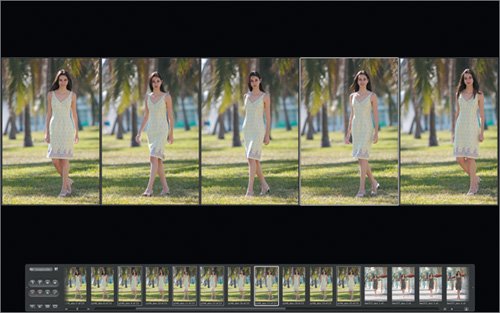 The five favorite tropical shots appear against a black background, and a filmstrip appears at the bottom of the screen. The filmstrip in Full Screen mode is similar to the control bar in the Aperture main window. You can use the filmstrip's controls to move through, rotate, view, and rate your images. Full Screen mode also has its own toolbar, although you might not see it yet. The five favorite tropical shots appear against a black background, and a filmstrip appears at the bottom of the screen. The filmstrip in Full Screen mode is similar to the control bar in the Aperture main window. You can use the filmstrip's controls to move through, rotate, view, and rate your images. Full Screen mode also has its own toolbar, although you might not see it yet.
| | | 3. | Position the cursor in the black area at the top of the screen. The toolbar appears. Click the Always Show Toolbar button.
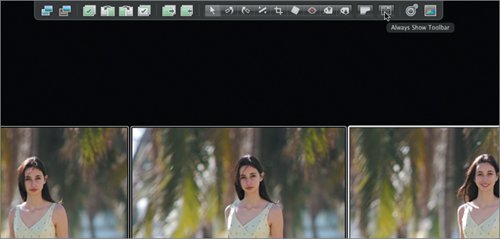 The toolbar is now a fixture on the screen and will not hide when you move your cursor away from it. You do not have to activate the Always Show Toolbar button to use the toolbar. The Full Screen toolbar contains many of the same buttons as the regular Aperture toolbar; however, it cannot be customized. The toolbar is now a fixture on the screen and will not hide when you move your cursor away from it. You do not have to activate the Always Show Toolbar button to use the toolbar. The Full Screen toolbar contains many of the same buttons as the regular Aperture toolbar; however, it cannot be customized.
Tip Tools that are in the regular toolbar but not visible on the Full Screen toolbar are still accessible via their usual keyboard shortcuts. | 4. | If necessary, press T to display the metadata overlay so that you can see the image filenames. Then, look at the image y246_alss 12 of 23.
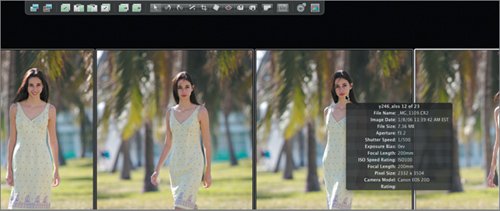 The dress shape looks nice in this shot, but the model's hidden right arm and the strands of hair across her face are a concern. Let's take a closer look. The dress shape looks nice in this shot, but the model's hidden right arm and the strands of hair across her face are a concern. Let's take a closer look.
| | | 5. | Select the Loupe or press the accent grave (`) key. Position the Loupe over the model's face in the image y246_alss 12 of 23.
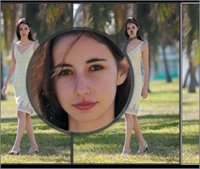 On closer inspection, you can see there are quite a few strands of hair streaming across her face. That won't do.
| 6. | Command-click y246_alss 12 of 23 to deselect the image. Then, click the Loupe to turn it off.
The image disappears from the Full Screen mode display area but is still in the filmstrip.
| 7. | Click the image y246_alss 20 of 23 to make it the primary selection.
Let's see it close up.
| 8. | Press Option-R to switch the view to Primary.
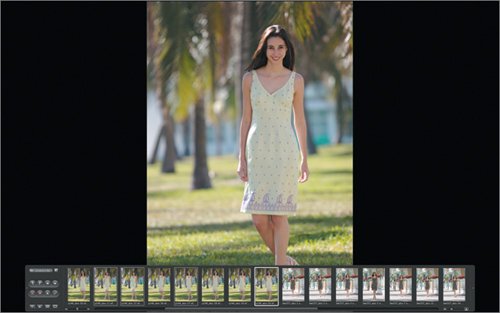 All images except the primary selection close. The filmstrip now covers up part of the primary image, but the bottom is an important portion of this image. A quick adjustment to the filmstrip is in order. All images except the primary selection close. The filmstrip now covers up part of the primary image, but the bottom is an important portion of this image. A quick adjustment to the filmstrip is in order.
| | | 9. | Click the Viewer Mode button on the filmstrip and choose Avoid from the pop-up menu, or press Control-V.
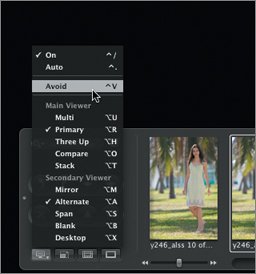 The image shrinks slightly so that it is not covered by the filmstrip.
 Switching to the Primary view is a great way of focusing on one image. And this one looks excellent. It conveys emotion and shows off the garment nicelya good combination. This is our first hero image. Switching to the Primary view is a great way of focusing on one image. And this one looks excellent. It conveys emotion and shows off the garment nicelya good combination. This is our first hero image.
|
|
 The five favorite tropical shots appear against a black background, and a filmstrip appears at the bottom of the screen. The filmstrip in Full Screen mode is similar to the control bar in the Aperture main window. You can use the filmstrip's controls to move through, rotate, view, and rate your images. Full Screen mode also has its own toolbar, although you might not see it yet.
The five favorite tropical shots appear against a black background, and a filmstrip appears at the bottom of the screen. The filmstrip in Full Screen mode is similar to the control bar in the Aperture main window. You can use the filmstrip's controls to move through, rotate, view, and rate your images. Full Screen mode also has its own toolbar, although you might not see it yet. The toolbar is now a fixture on the screen and will not hide when you move your cursor away from it. You do not have to activate the Always Show Toolbar button to use the toolbar. The Full Screen toolbar contains many of the same buttons as the regular Aperture toolbar; however, it cannot be customized.
The toolbar is now a fixture on the screen and will not hide when you move your cursor away from it. You do not have to activate the Always Show Toolbar button to use the toolbar. The Full Screen toolbar contains many of the same buttons as the regular Aperture toolbar; however, it cannot be customized. The dress shape looks nice in this shot, but the model's hidden right arm and the strands of hair across her face are a concern. Let's take a closer look.
The dress shape looks nice in this shot, but the model's hidden right arm and the strands of hair across her face are a concern. Let's take a closer look.
 All images except the primary selection close. The filmstrip now covers up part of the primary image, but the bottom is an important portion of this image. A quick adjustment to the filmstrip is in order.
All images except the primary selection close. The filmstrip now covers up part of the primary image, but the bottom is an important portion of this image. A quick adjustment to the filmstrip is in order.
 Switching to the Primary view is a great way of focusing on one image. And this one looks excellent. It conveys emotion and shows off the garment nicelya good combination. This is our first hero image.
Switching to the Primary view is a great way of focusing on one image. And this one looks excellent. It conveys emotion and shows off the garment nicelya good combination. This is our first hero image.